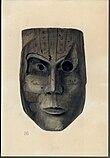Little Salt Spring
Little Salt Spring | |
 Little Salt Spring in November 2006 | |
| Location | North Port, Florida, U.S. |
|---|---|
| Coordinates | 27°4′29″N 82°14′0″W / 27.07472°N 82.23333°W |
| NRHP reference No. | 79000692[1] |
| Added to NRHP | July 10, 1979 |
Little Salt Spring is an archaeological and paleontological site in North Port, Florida. The site has been owned by the University of Miami since 1980[2][3] with research performed there by the university's Rosenstiel School of Marine, Atmospheric, and Earth Science.
History
[edit]Little Salt Spring is a feature of the karst topography of Florida, specifically an example of a sinkhole. It is classified as a third magnitude spring.[4] The numerous deep vents at the bottom of the sinkhole feed oxygen-depleted groundwater into it, producing an anoxic environment below a depth of about 5 m (16.4 ft).[4] This fosters the preservation of Paleo-Indian and early Archaic artifacts and ecofacts, as well as fossil bones of the extinct megafauna once found in Florida.[5][6][7]
Little Salt Spring was considered a shallow freshwater pond, but in 1959 SCUBA divers William Royal and Eugenie Clark discovered that it was a true sinkhole extending downward over 200 ft (61 m),[4][8] similar to the cenotes of the Yucatán Peninsula (another karst region). The actual depth of the surface pond is forty feet (12.2 m) with a central shaft dropping vertically to an inverted cone with a maximum determined depth at the outer edges of 245 feet (75 m). There are ledges around the wall of the cenote at 16 and 27 meters (52 and 89 feet) below the present water level.
The water level in the spring has varied over time. Twelve to thirteen thousand years ago the ocean level was about 100 meters (more than 300 feet) lower than at present, drawing down the water table in Florida, and the water level in Little Salt Spring was 27 meters (89 feet) lower than at present. The basin around the spring and a slough extending away from it are filled with moist, soft peat.
On July 10, 1979, the site was added to the National Register of Historic Places.[2] In 2013, the University of Miami began considering selling the site to Sarasota County Government, due to funding being cut towards maintaining the site and its facilities.[9]
Prehistoric human use
[edit]Hundreds of burials dating from 5,200 to 6,800 years ago have been found in the slough. As has happened in other wetland burials in Florida, such as at the Windover Archaeological Site, brain matter survived in many of the skulls. In the 1970s the overturned shell of an extinct giant land tortoise was found on the 27-meter (89 ft) ledge. A wooden stake had been driven between the carapace and the plastron, and there is evidence of a fire under the tortoise. It appears that the tortoise had been cooked in its shell. The radiocarbon date for the wooden stake was 12,030 years ago; a bone from the tortoise was dated to 13,450 years ago. Large numbers of human bones have been recovered from the spring, but were not collected under controlled conditions.[10]
See also
[edit]References
[edit]- ^ "National Register Information System". National Register of Historic Places. National Park Service. July 9, 2010.
- ^ a b "Dial Hotline". Sarasota Herald Tribune. November 24, 1980. p. 54. Retrieved February 6, 2010.
- ^ Maynard, Ashleigh (February 25, 2009). "Little Salt Spring makes big news nationwide". Miami Hurricane. Retrieved February 5, 2010. (reports the transfer date as 1982)
- ^ a b c Van Ee, NJ; Riera-Gomez, E Rick (2009). "Oxygen and Hydrogen Isotopes Suggest Two Sources for Little Salt Spring". In: Pollock NW, ed. Diving for Science 2009. Proceedings of the American Academy of Underwater Sciences 28th Symposium. Dauphin Island, AL. Archived from the original on June 15, 2013. Retrieved May 15, 2013.
{{cite journal}}: CS1 maint: unfit URL (link) - ^ "Little Salt Spring Reveals More Florida History". July 6, 2005. Archived from the original on September 22, 2006. Retrieved November 16, 2009.
- ^ Clausen, C. J.; A. D. Cohen; Cesare Emiliani; J. A. Holman; J. J. Stipp (February 16, 1979). "Little Salt Spring, Florida: A Unique Underwater Site". Science. 203 (4381): 609–614. Bibcode:1979Sci...203..609C. doi:10.1126/science.203.4381.609. PMID 17813360. S2CID 39027766. Retrieved February 5, 2010.
- ^ Alvarez Zarikiana, Carlos A.; Peter K. Swart; John A. Gifford; Patricia L. Blackwelder (August 5, 2005). "Holocene paleohydrology of Little Salt Spring, Florida, based on ostracod assemblages and stable isotopes". Palaeogeography, Palaeoclimatology, Palaeoecology. 225 (1–4): 134–156. Bibcode:2005PPP...225..134A. doi:10.1016/j.palaeo.2004.01.023.[dead link]
- ^ Royal, William R.; Burgess, Robert Forrest (1978). The man who rode sharks. New York: Dodd, Mead. ISBN 978-0-396-07537-0.
- ^ Taylor, Josh (June 5, 2013). "Little Salt Spring could be sold to Sarasota County - Sarasota News | Mysuncoast.com and ABC 7: 7 South Newsroom". Mysuncoast.com. Retrieved June 13, 2013.
- ^ Purdy, Barbara A. (2008). Florida's People During the Last Ice Age. Gainesville, Florida: University Press of Florida. pp. 84–90. ISBN 978-0-8130-3204-7.
External links
[edit]- Sarasota County listings at National Register of Historic Places
- Sarasota County listings at Florida's Office of Cultural and Historical Programs
- Little Salt Spring at the Marine Affairs and Policy Division of Rosenstiel School of Marine, Atmospheric, and Earth Science at the University of Miami
- National Register of Historic Places in Sarasota County, Florida
- University of Miami
- Archaeological sites in Florida
- Sinkholes of Florida
- Bodies of water of Sarasota County, Florida
- Archaeological sites on the National Register of Historic Places in Florida
- Underwater archaeological sites
- North Port, Florida




